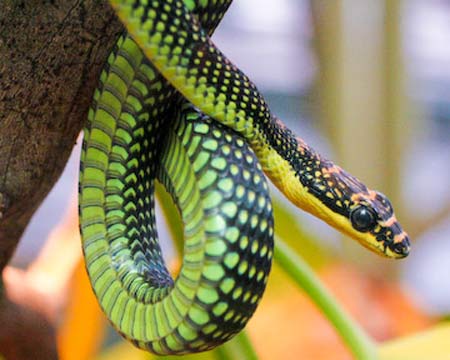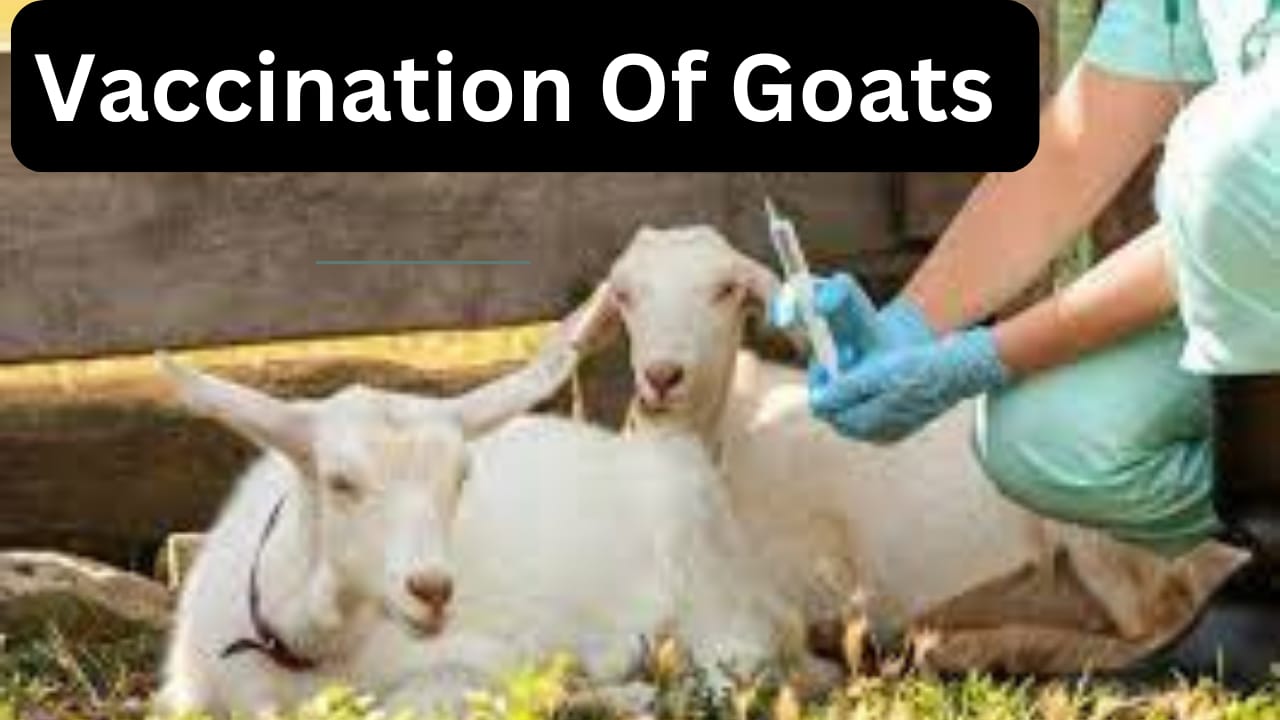
Golden Flying Snake
Golden Flying Snake
The Golden Flying Snake (Chrysopelea ornata) is a species of tree-dwelling snake found in Southeast Asia, particularly in Thailand, Myanmar, Malaysia, and Indonesia. As the name suggests, this snake is known for its ability to glide through the air from tree to tree using its flattened body and tail as wings.
The Golden Flying Snake is a slender snake, typically growing up to around 1.2 meters (4 feet) in length. It has a beautiful golden-yellow coloration on its upper body, which fades into a pale yellow or white on the underside. The scales are smooth and glossy, giving the snake a striking appearance.
When it wants to glide, the Golden Flying Snake climbs to a high point on a tree and then launches itself into the air, flattening its body and using its tail to steer. It can travel up to 100 meters (330 feet) in a single glide, and can even change direction mid-flight by twisting its body.
Despite its name and ability to glide, the Golden Flying Snake is not a true flying animal, as it cannot sustain flight and can only glide for short distances. It still relies on climbing and slithering to move around on the ground.
The Golden Flying Snake is not considered dangerous to humans and is not venomous, though it can bite if threatened or provoked. It primarily feeds on small rodents and lizards, which it hunts from trees and bushes.

Classification
The Golden Flying Snake (Chrysopelea ornata) belongs to the family Colubridae, which is a diverse group of non-venomous snakes found throughout much of the world. Within the family Colubridae, the Golden Flying Snake is classified under the subfamily Colubrinae, which includes many other arboreal and semi-arboreal snake species.
The scientific classification of the Golden Flying Snake is as follows:
Kingdom: Animalia
Phylum: Chordata
Class: Reptilia
Order: Squamata
Suborder: Serpentes
Family: Colubridae
Subfamily: Colubrinae
Genus: Chrysopelea
Species: Chrysopelea ornata
Characteristics Golden Flying Snake
The Golden Flying Snake (Chrysopelea ornata) has several unique characteristics that help it glide through the air and thrive in its arboreal habitat.
Here are some of its notable features:
1. Flattened body: The Golden Flying Snake has a flattened body that is wider from side to side than from top to bottom. This allows it to create lift and glide through the air when it launches itself from a high point.
2. Prehensile tail: The snake's tail is long and prehensile, meaning it can grasp onto branches and other objects, providing stability and control during flight.
3. Glossy scales: The Golden Flying Snake has smooth, glossy scales that reduce air resistance and help it move quickly and gracefully through the air.
4. Coloration: As its name suggests, the Golden Flying Snake has a striking golden-yellow coloration on its upper body, which fades into a pale yellow or white on the underside. This coloration helps it blend in with the sunlit foliage of its arboreal habitat.
5. Arboreal habitat: The Golden Flying Snake is primarily found in trees and bushes, where it hunts for small rodents and lizards. Its flattened body and prehensile tail make it well adapted for this arboreal lifestyle.
6. Non-venomous: The Golden Flying Snake is a non-venomous species and is not considered dangerous to humans. However, it may bite if threatened or provoked.
7. Gliding ability: The Golden Flying Snake is able to glide through the air for short distances by flattening its body and using its tail to steer. It can travel up to 100 meters (330 feet) in a single glide and change direction mid-flight by twisting its body.
Behaviors Golden Flying Snake
The Golden Flying Snake (Chrysopelea ornata) has several interesting behaviors that help it survive in its arboreal habitat.
Here are some of its notable behaviors:
1. Arboreal lifestyle: The Golden Flying Snake spends most of its time in trees and bushes, where it hunts for small rodents and lizards.
2. Gliding: The Golden Flying Snake is able to glide through the air for short distances by flattening its body and using its tail to steer. It typically glides from tree to tree or to the ground to avoid predators or find food.
3. Nocturnal activity: The Golden Flying Snake is primarily active at night when it is cooler and there is less risk of predation.
5. Camouflage: The snake's golden-yellow coloration helps it blend in with the sunlit foliage of its arboreal habitat, making it difficult for predators to spot.
6. Alertness: The Golden Flying Snake is alert and agile, always ready to take off and glide away at a moment's notice. This helps it avoid predators and capture prey.
7. Non-aggressive behavior: The Golden Flying Snake is a non-aggressive species and is not considered dangerous to humans. It typically tries to avoid confrontation and may only bite if threatened or provoked.
8. Prey hunting: The Golden Flying Snake hunts for small rodents and lizards by ambushing them from trees and bushes. It typically strikes quickly and uses its sharp teeth to hold onto its prey while it constricts it with its body.
The Golden Flying Snake is a fascinating species that has evolved a variety of behaviors to help it survive in its arboreal habitat. Its ability to glide through the air is particularly remarkable and has earned it a reputation as one of the most acrobatic and graceful snakes in the world.
Diet Golden Flying Snake
The Golden Flying Snake (Chrysopelea ornata) primarily feeds on small rodents and lizards, which it hunts for in its arboreal habitat.
Here are some more details about its diet:
1. Rodents: The Golden Flying Snake feeds on a variety of small rodents, including mice, rats, and voles. It typically hunts for these animals by ambushing them from trees and bushes and striking quickly with its sharp teeth.
2. Lizards: In addition to rodents, the Golden Flying Snake also feeds on small lizards, such as geckos and skinks. It may hunt for these animals in a similar manner to rodents or may climb onto low-lying branches to capture them.
3. Insects: While not a major part of its diet, the Golden Flying Snake may also eat small insects, such as crickets or grasshoppers, on occasion.
4. Carnivorous diet: As a carnivorous species, the Golden Flying Snake does not eat any plants or fruits, and relies solely on animal-based food sources to meet its nutritional needs.
Habitat Golden Flying Snake
The Golden Flying Snake (Chrysopelea ornata) is found in a variety of habitats throughout Southeast Asia, including forests, jungles, and agricultural areas.
Here are some more details about its habitat:
1. Arboreal habitat: The Golden Flying Snake is a primarily arboreal species, meaning it spends most of its time in trees and bushes. It is well adapted to this habitat, with a flattened body, prehensile tail, and glossy scales that help it move quickly and gracefully through the air.
2. Forests and jungles: The Golden Flying Snake is commonly found in forests and jungles throughout Southeast Asia, where it can find an abundance of prey and suitable trees to glide from.
3. Agricultural areas: The Golden Flying Snake may also be found in agricultural areas, such as rice paddies and orchards, where it can hunt for rodents and other small prey.
4. Elevations: The Golden Flying Snake has been found at elevations ranging from sea level up to around 1,500 meters (4,900 feet) in some areas.
5. Range: The Golden Flying Snake is found in several Southeast Asian countries, including Indonesia, Malaysia, Thailand, Vietnam, and the Philippines.
The Golden Flying Snake is well adapted to its arboreal habitat and can be found in a variety of environments throughout Southeast Asia. Its range includes forests, jungles, and agricultural areas, where it can find an abundance of prey and suitable trees to glide from.
How Venomous is the Golden Flying Snake?
The Golden Flying Snake (Chrysopelea ornata) is not considered venomous to humans. It is a non-venomous species and its bite is not known to cause any significant harm. However, as with any wild animal, it is still important to treat the Golden Flying Snake with caution and respect, and to avoid handling it if possible. Even non-venomous snakes can bite and cause injury if they feel threatened or provoked. It is always best to observe these animals from a safe distance and avoid disturbing them in their natural habitat.
Population and Conservation Status
The population and conservation status of the Golden Flying Snake (Chrysopelea ornata) are not well documented, but the species is generally believed to be widespread and relatively common throughout its range in Southeast Asia.
Here are some more details about its population and conservation status:
1. Population: While there are no exact population estimates for the Golden Flying Snake, it is generally believed to be a common and widespread species throughout its range. It is not considered to be at risk of extinction.
2. Conservation status: The Golden Flying Snake is not currently listed on the IUCN Red List of Threatened Species. However, like many species of snakes, it may face threats from habitat loss, fragmentation, and degradation due to human activities such as deforestation and agriculture. Additionally, some individuals may be caught for the pet trade, although this is not believed to be a major threat to the species as a whole.
4. Protection: While the Golden Flying Snake is not currently protected by any specific laws or regulations, it may be protected under broader conservation laws and regulations in some countries within its range.
The Golden Flying Snake is considered to be a common and widespread species, although it may face threats from habitat loss and degradation due to human activities. As with all species, it is important to monitor its population and habitat trends to ensure that it remains healthy and stable in the future.
Are Golden Flying Snake Aggressive?
The Golden Flying Snake (Chrysopelea ornata) is not typically an aggressive species, and it will generally try to avoid human contact if possible. Like most snakes, it may become defensive or aggressive if it feels threatened or cornered, but it is not known for being particularly aggressive or dangerous to humans. If encountered in the wild, it is best to give the Golden Flying Snake plenty of space and observe it from a safe distance. It is important to remember that even non-venomous snakes can bite and cause injury if they feel threatened or provoked, so it is always best to treat these animals with caution and respect.
What happens if you’re bitten by a Golden Flying Snake?
The Golden Flying Snake (Chrysopelea ornata) is not venomous to humans, so a bite from this species is not considered medically significant. However, as with any animal bite, it is important to clean the wound thoroughly and monitor it for signs of infection. If you experience any unusual symptoms or complications, such as severe pain, swelling, or fever, it is best to seek medical attention. In general, bites from non-venomous snakes like the Golden Flying Snake are usually not serious and will heal on their own with proper care and attention. It is always best to avoid handling these animals if possible, and to give them plenty of space and respect in their natural habitat.
Here are some fun facts about the Golden Flying Snake:
1. The Golden Flying Snake is also known as the Golden Tree Snake or the Ornate Gliding Snake.
2. Despite its name, the Golden Flying Snake cannot actually fly. It is capable of gliding through the air by flattening its body and using its prehensile tail to steer, but it still relies on gravity and cannot fly like a bird or bat.
3. The Golden Flying Snake is a skilled hunter, and it is known to feed on a variety of prey, including lizards, frogs, rodents, and birds.
4. The Golden Flying Snake is a diurnal species, meaning it is most active during the day.
5. The Golden Flying Snake is an arboreal species and spends most of its time in trees and bushes, where it can glide from branch to branch in search of prey.
6. The Golden Flying Snake is an oviparous species, meaning it lays eggs to reproduce. Females may lay up to 12 eggs at a time.
7. The Golden Flying Snake is known for its distinctive coloration, which includes bright green and yellow scales on its back and sides, and black scales on its belly.
8. The Golden Flying Snake has a long, slender body that can reach up to 1 meter (3.3 feet) in length.
9. The Golden Flying Snake is a non-venomous species and is not considered to be dangerous to humans.
10. The Golden Flying Snake is a fascinating and unique species, and its ability to glide through the air has made it a popular subject of study and fascination among herpetologists and nature enthusiasts.
Blog Upload on - April 29, 2023
Views - 3211

posted By -
Animals Super Store
Related Posts
-
Goat Farming Business
Sept. 28, 2022 -
Healthy Habits For Animals
Oct. 26, 2023 -
 Top 10 Highest Flying Birds
Top 10 Highest Flying Birds
March 1, 2023 -
 Vaccination Of Goat And Sheep
Vaccination Of Goat And Sheep
Nov. 7, 2022 -
 Black Mamba
Black Mamba
April 14, 2023 -
 Types Of Fish Breed Names A to Z
Types Of Fish Breed Names A to Z
Nov. 25, 2022 -
Bakrid 2022
April 19, 2022 -
The 10 Best Dog-Friendly Places To Go In Your India
Oct. 17, 2023


I see that your site is very informative, and every article is better than any other website's blog and articles. Your blog contains more information than any other. I think you are one of the best informative article writers, also I am sure you are. Somehow, I found another informative blog site that contains more information same as you. If you want more information about farming, then you can visit farmingplan.com sites. Farming Plan